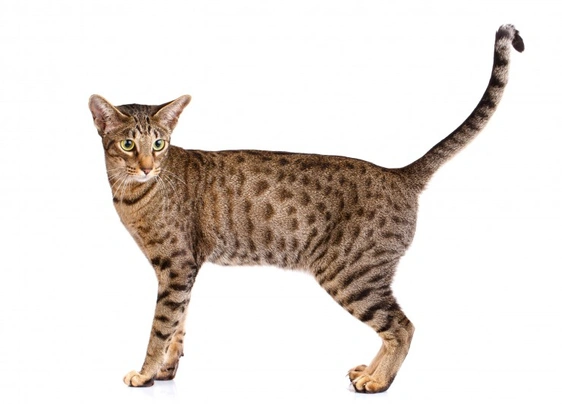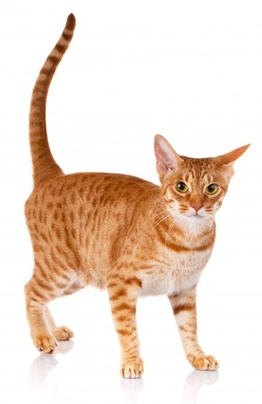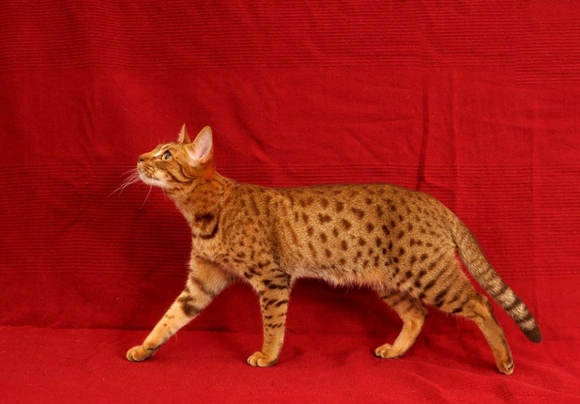Ocicat
Introduction of the Ocicat
The Ocicat was first developed in the United States quite by accident but these lovely wild looking cats soon made their mark on the cat world. They are medium to large in size and boast having a gorgeous spotted coat that resembles that of an Ocelot hence their name. They are domestic cats and do not have any wild genes in their bloodlines. Over the years the Ocicat has become known as an affectionate loyal cat and they have found their way into the hearts and homes of people all over the world including the UK.
History of the Ocicat
Ocicats first appeared on the scene quite by accident in 1964 when an American breeder was hoping to create a Siamese that boasted the same colour points as that of an Abyssinian. However in a second generation litter there was a kitten that boasted charming golden and ivory spots. The kitten was a male and his coat looked much like that of an Ocelot. As such it was decided to call the kitten Tonga and he was nicknamed "Ocicat".
It was not long before more breeders decided to continue the line so they could produce more kittens with spotted coats and they did so by crossing Siamese to the Abyssinian as well as their offspring. A little later the American Shorthair was introduced into the mix which broadened the gene pool considerably and it also meant the breed was more robust and larger boned. It also meant that "silver" was added to six of the breed's colours.
In 1987 the breed was recognised by The Cat Fanciers' Association and given Championship status. It was not long before other international breed associations accepted the Ocicat into their registries. Today these charming wild looking cats have found their way into the hearts and homes of many people throughout the world not only because of their exotic looks but also because they boast having such affectionate and kind natures often behaving much like a dog.
Appearance of the Ocicat
Ocicats have a wild look about them thanks to their golden and ivory spotted coats. They are in fact a man-made medium to large size cat and do not have any "wild" genes in their ancestry at all. They have long well-muscled bodies with their tails being just as long. They are extremely graceful when they move and very attractive with their spots being distinctively placed each side of their bodies across their shoulders their hindquarters and down a cat's legs. They also have nicely spotted bellies.
Their heads are a modified wedge being longer than they are wide and having a slight curve from their cheeks to their muzzles with a distinct yet gentle rise from the bridge of a cat's nose to their brow. When seen in profile there's a slight dip but no nose break. Muzzles are well defined and broad being rather square when seen in profile and being longer than they are wide. Chins are firm and strong with cats having strong jaws and level bites. They have a slight whisker pinch and cats carry their heads elegantly thanks to their arched necks. Males tend to have more of a jowl than their female counterparts.
Their ears are moderately large being wider at the base and set at an angle on their heads not too high or too low and with a good width between them. The tips of their ears are nicely rounded with vertical tufts on the tips. Some cats don't have tufted ears which is acceptable under the GCCF breed standard. Their eyes are almond-shaped being large with a slight upwards angle towards a cat's ears. Eyes can be any colour with the exception of blue.
They have solid well-muscled long bodies that show a good amount of bone with rather broad deep chests. They have straight backs which are slightly higher at their back-ends which adds to a cat's athletic look. Ocicats are much heavier than they appear with females being a little smaller than their female counterparts. Their legs are well-muscled and moderately long being powerful and well in proportion to the rest of a cat's body. Paws are nicely compact and oval shaped. Their tails are quite long and well in proportion to the body being broader at the base with only a slight amount of tapering to the tip which adds to their “wild” appearance.
When it comes to their coat the Ocicat boasts having a short close-lying coat which boasts being extremely lustrous and which is satiny in texture. They come in various colours which are as follows:
- Tawny - with or without silver
- Chocolate - with or without silver
- Cinnamon - with or without silver
- Blue - with or without silver
- Lilac - with or without silver
- Fawn - with or without silver
- Classic Tabby (striped) coat pattern
Temperament of the Ocicat
The Ocicat is known to be quite dog-like in their behaviour and they form extremely strong bonds with their owners. Being so intelligent they are easy to train especially as they respond so well to voice. With this said they are independent by nature and quite extrovert with it. They are particularly good around children and become totally devoted to their families loving nothing more than to be in their company.
Ocicats are confident outgoing and love being kept busy always eager to be involved in everything that goes on in their environment. They enjoy playing interactive games like fetch and will even play "tug of war" when anyone tries to take a toy away from them. Once tired an Ocicat is just as happy to curl up on an owner's lap for a cuddle and a snooze. They are quite talkative by nature and are quick to let an owner know when it's feeding time and they do so by chirping much like a bird. They also greet their owners in a very vocal way when they return home after having been out for a while.
They boast having a ton of energy and enjoy being able to climb up high so they can perch and look down on the world below them. Because they form such strong ties with their owners Ocicats never like to be left on their own for any length of time. As such they are best suited to households where at least one person stays at home when everyone else is out of the house or where there are other family pets which could be a dog or a cat they have grown up with.
They adore being able to explore the great outdoors but cats should only be allowed to go outside if it is safe for them to do so. Many owners like to keep their Ocicats as indoor pets especially if they live in town on near a main road.
Intelligence / Trainability of the Ocicat
Ocicats are very intelligent and can be trained to do things similar to a dog because they respond so well to voice commands. They love playing interactive games and become quite possessive of their toys, which leads them to play tug-of-war when someone tries to take anything from them. Being so smart, they need a lot of things to keep their minds occupied, which means investing in high-quality scratching posts, building elevated platforms for the cat to climb and either perch on or nap. When kept as indoor pets, Ocicats need the right amount of mental stimulation and activity to be truly happy. If they don't have enough to do, boredom sets in quickly, which can lead a cat to become a bit destructive around the house.
Children and other
Ocicats with their outgoing affectionate personalities are the perfect choice for families with children. They are confident and quick on their feet which means they know when to get out of the reach of smaller children when they get too boisterous or loud. With this said younger children need to be taught how to behave around cats and more especially when to leave them alone.
They also get on well with dogs if they have grown up together in the same household. However care has to be taken when introducing an Ocicat to dogs they don't already know just in case the dog does not get on with their feline counterparts. They are incredibly social by nature and have been known to get on with some smaller animals. However it's always wiser to keep a close eye on any cat when they are around smaller pets just in case their hunting instinct kicks in with disastrous results.
Health of the Ocicat
The average life expectancy of an Ocicat is between 15 and 18 years when properly cared for and fed an appropriate good quality diet to suit their ages.
The Ocicat is known to be a healthy and robust breed and one that does not appear to suffer from the hereditary health issues that affect other breeds. However stud cats need to be tested for any breed specific hereditary health issues before being used in a breeding programme.
Caring for the Ocicat
As with any other breed Ocicats need to be groomed on a regular basis to make sure their coats and skin are kept in top condition. On top of this cats need to be fed good quality food that meets all their nutritional needs throughout their lives which is especially true of kittens and older cats.
Grooming of the Ocicat
Ocicats boast having short close lying coats and as such they are low maintenance on the grooming front. A weekly brush and wipe over with a chamois leather is all it takes to keep their coats in good condition with a nice sheen on it. Like other breeds they tend to shed the most in the Spring and then again in the Autumn when more frequent brushing is usually necessary to keep on top of things.
It's also important to check a cat's ears on a regular basis and to clean them when necessary. If too much wax is allowed to build up it can lead to a painful infection which can be hard to clear up. In short prevention is often easier than cure with ear infections. Cats often suffer from ear mites which can be a real problem which is why it's so important to check their ears on a regular basis.
Exercise of the Ocicat
The Ocicat is a high energy cat and one that loves being kept busy when they are not napping that is. Being so smart they need to be given enough mental stimulation for them to be truly happy. Like other breeds the Ocicat enjoys being able to explore their territory but they should only be allowed to go outside if it is safe for them to do so. Most owners like to keep their cats as indoor pets especially if they live in a town or near a main road. The good news is that Ocicats are very adaptable and are quite happy being kept as indoor pets.
However cats kept as indoor pets need to be given lots of things to do and places to hide when they want to bearing in mind that an Ocicat loves to climb up high so they can watch the world below them while they perch. They also need to have lots of places they can snuggle up for a snooze when the mood takes them because if there is one thing Oiccats enjoy doing it's napping throughout the day.
Feeding of the Ocicat
If you get an Ocicat kitten from a breeder they would give you a feeding schedule and it's important to stick to the same routine feeding the same kitten food to avoid any tummy upsets. You can change a kitten's diet but this needs to be done very gradually always making sure they don't develop any digestive upsets and if they do it's best to put them back on their original diet and to discuss things with the vet before attempting to change it again.
Older cats are not known to be fussy eaters but this does not mean they can be given a lower quality diet. It's best to feed a mature cat several times a day making sure it's good quality food that meets all their nutritional requirements which is especially important as cats get older. It's also essential to keep an eye on a cat's weight because if they start to put on too much it can have a serious impact on their overall health and wellbeing. Like all other breeds Ocicats need access to fresh clean water at all times.
Ocicat price
If you are looking to buy an Ocicat you would need to pay upwards of £250 for a well-bred pedigree kitten and you would need to register your interest with breeders and agree to being put on a waiting list because not many well-bred kittens are registered with the GCCF every year. The cost of insuring a male 3-year-old Ocicat in northern England would be £15.53 a month for basic cover but for a lifetime policy this would set you back £25.17 a month (quote as of December 2017). When insurance companies calculate a pet's premium they factor in several things which includes where you live in the UK a cat's age and whether or not they have been neutered or spayed among other things.
When it comes to food costs you need to buy the best quality food whether wet or dry making sure it suits the different stages of a cat’s life. This would set you back between £15 - £20 a month. On top of all of this you need to factor in veterinary costs if you want to share your home with an Ocicat and this includes their initial vaccinations their annual boosters the cost of neutering or spaying a cat when the time is right and their yearly health checks all of which quickly adds up to over £500 a year.
As a rough guide the average cost to keep and care for an Ocicat would be between £30 to £50 a month depending on the level of insurance cover you opt to buy for your cat but this does not include the initial cost of buying a well-bred kitten.


